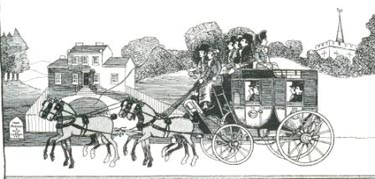
The Hockerill Turnpike Trust, or more accurately 'The Essex and Herts Turnpike Trust', was formed in 1774 by Act of Parliament. It was responsible for the 29 miles of road between Harlow and Great Chesterford. A two mile stretch passed through the Parish of Thorley between Spellbrook and South Mill. Significant references exist in the Trust's accounts regarding incidents that occurred on our parish boundaries - at the Spellbrook Toll Gate and then at the bridge over the River Stort at South Mill.
The watermill at South Mill was exactly half way between Whitehall and Newmarket for royal racing purposes. Disputes constantly arose over the rebuilding and maintenance of a bridge next to the mill. When the river was in flood and the main road ford impassable the alternative route was across a private bridge beside the mill. This caused constant annoyance, disruption and litigation for the mill owners.
By the Act of 1555 parishes were obliged to supply labour, materials and transport to repair all roads within their parish. Each parish was obliged to elect a surveyor to supervise the work and each householder had to supply four days labour a year. The availability of good building materials and the underlying condition of the land meant maintenance was of variable quality. Private Turnpike Trusts originated in the late 1600s with the first gate being set up at Wadesmill on the Great Cambridge Road (A10). The intention was for the road user to pay towards the damage caused by increased traffic instead of the local parishioners.
In the 1700s and 1800s Bishop's Stortford was the centre of the barley malting industry and the Thorley road to London was used extensively by heavily laden wagons and packhorses. This heavy usage together with postal and passenger stage coaches led to the formation of the Hockerill Turnpike Trust. Initially two toll gates were set up at Spellbrook (Greyhound Inn) and at Ugley (Chequers Inn) and fees charged according to the size of vehicle and number of animals passing through a barred gate with spikes or pikes on top.
 |
|
From an advertisement for the London to Norwich Stagecoach
|
Due to the impassability of the narrow streets and tight bends in Bishop's Stortford, the toll road by-passed the town centre and ran from Thorley to Hockerill. The Crown Inn at Hockerill was also a convenient stopping place for changing horses and taking refreshments. From 1784 until the coming of the railway in the mid 1800s, Bishop's Stortford was an important centre for passing and connecting mail coaches from London to other towns in East Anglia. Hockerill crossroads had four inns serving the passing trade.
Two obvious legacies of the Turnpike Trust in Thorley are evident today. One happened in the 1820s with the lowering and widening of the hill as it passes The Bishop's Stortford High School. The second is the requirement for the Turnpike trusts to install milestones. A 1911 archive photograph of our 27 mile milestone (to London) and 2 miles to Bishop's Stortford exists showing the stone which used to be set outside The Blue House in Thorley Street. Other still standing milestones are to be found in London Road just to the north of the railway bridge (28 miles) and in Stansted Road north of the Wagon and Horses pub (29 miles to London).
In May 1822 the Trustees appointed the talented surveyor James McAdam as their general surveyor. He had already been appointed to other turnpikes on the London to Norwich road. A comprehensive plan was drawn up for the repair and maintenance of the highway and its bridges and in general the finances were better managed. The Hockerill Turnpike Trust was wound up in 1869 due to competition from the railways. Responsibility for road maintenance was taken over by the newly constituted local and county councils.
Bill Hardy
July 2006
Acknowledgements.
W.J.Wright - The Roads of Bishop's Stortford - 1989
F.H. Maud - The Hockerill Highway - 1957
Paul Ailey - www.stortfordhistory.co.uk